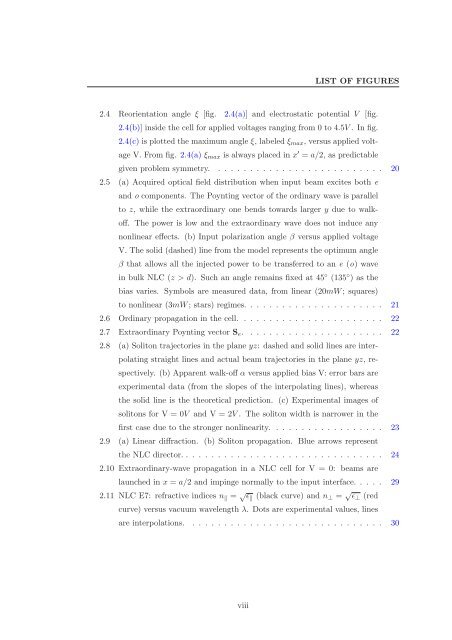Solitons in Nonlocal Media
Solitons in Nonlocal Media
Solitons in Nonlocal Media
Create successful ePaper yourself
Turn your PDF publications into a flip-book with our unique Google optimized e-Paper software.
LIST OF FIGURES<br />
2.4 Reorientation angle ξ [fig. 2.4(a)] and electrostatic potential V [fig.<br />
2.4(b)] <strong>in</strong>side the cell for applied voltages rang<strong>in</strong>g from 0 to 4.5V . In fig.<br />
2.4(c) is plotted the maximum angle ξ, labeled ξmax, versus applied volt-<br />
age V. From fig. 2.4(a) ξmax is always placed <strong>in</strong> x ′ = a/2, as predictable<br />
given problem symmetry. . . . . . . . . . . . . . . . . . . . . . . . . . . 20<br />
2.5 (a) Acquired optical field distribution when <strong>in</strong>put beam excites both e<br />
and o components. The Poynt<strong>in</strong>g vector of the ord<strong>in</strong>ary wave is parallel<br />
to z, while the extraord<strong>in</strong>ary one bends towards larger y due to walk-<br />
off. The power is low and the extraord<strong>in</strong>ary wave does not <strong>in</strong>duce any<br />
nonl<strong>in</strong>ear effects. (b) Input polarization angle β versus applied voltage<br />
V. The solid (dashed) l<strong>in</strong>e from the model represents the optimum angle<br />
β that allows all the <strong>in</strong>jected power to be transferred to an e (o) wave<br />
<strong>in</strong> bulk NLC (z > d). Such an angle rema<strong>in</strong>s fixed at 45 ◦ (135 ◦ ) as the<br />
bias varies. Symbols are measured data, from l<strong>in</strong>ear (20mW; squares)<br />
to nonl<strong>in</strong>ear (3mW; stars) regimes. . . . . . . . . . . . . . . . . . . . . . 21<br />
2.6 Ord<strong>in</strong>ary propagation <strong>in</strong> the cell. . . . . . . . . . . . . . . . . . . . . . . 22<br />
2.7 Extraord<strong>in</strong>ary Poynt<strong>in</strong>g vector Se. . . . . . . . . . . . . . . . . . . . . . 22<br />
2.8 (a) Soliton trajectories <strong>in</strong> the plane yz: dashed and solid l<strong>in</strong>es are <strong>in</strong>ter-<br />
polat<strong>in</strong>g straight l<strong>in</strong>es and actual beam trajectories <strong>in</strong> the plane yz, re-<br />
spectively. (b) Apparent walk-off α versus applied bias V: error bars are<br />
experimental data (from the slopes of the <strong>in</strong>terpolat<strong>in</strong>g l<strong>in</strong>es), whereas<br />
the solid l<strong>in</strong>e is the theoretical prediction. (c) Experimental images of<br />
solitons for V = 0V and V = 2V . The soliton width is narrower <strong>in</strong> the<br />
first case due to the stronger nonl<strong>in</strong>earity. . . . . . . . . . . . . . . . . . 23<br />
2.9 (a) L<strong>in</strong>ear diffraction. (b) Soliton propagation. Blue arrows represent<br />
the NLC director. . . . . . . . . . . . . . . . . . . . . . . . . . . . . . . . 24<br />
2.10 Extraord<strong>in</strong>ary-wave propagation <strong>in</strong> a NLC cell for V = 0: beams are<br />
launched <strong>in</strong> x = a/2 and imp<strong>in</strong>ge normally to the <strong>in</strong>put <strong>in</strong>terface. . . . . 29<br />
2.11 NLC E7: refractive <strong>in</strong>dices n = √ ǫ (black curve) and n⊥ = √ ǫ⊥ (red<br />
curve) versus vacuum wavelength λ. Dots are experimental values, l<strong>in</strong>es<br />
are <strong>in</strong>terpolations. . . . . . . . . . . . . . . . . . . . . . . . . . . . . . . 30<br />
viii
















